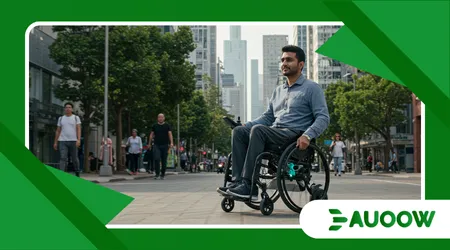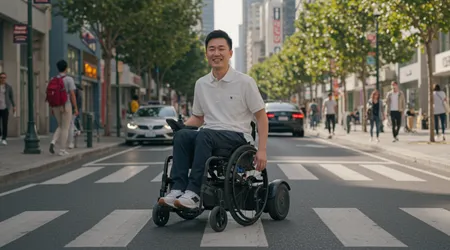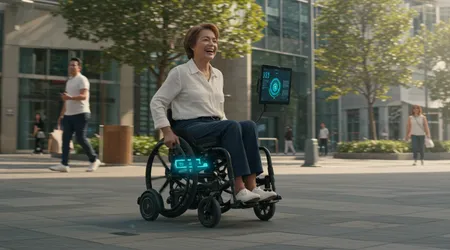How AI-Powered Wheelchairs Are Transforming Mobility in 2025

AI-Powered Wheelchairs are revolutionizing mobility, blending cutting-edge technology with human-centric design to empower individuals in 2025.
Imagine a world where wheelchairs anticipate your needs, navigate obstacles independently, and integrate seamlessly into daily life.
This isn’t science fiction it’s reality, driven by artificial intelligence advancements. From urban streets to rural paths, these devices are redefining independence for millions.
With over 75 million wheelchair users globally, according to the World Health Organization, the demand for smarter mobility solutions has never been greater.
This article explores how AI-Powered Wheelchairs are reshaping accessibility, enhancing user autonomy, and sparking a new era of inclusive innovation.
The journey to this point has been remarkable. Traditional wheelchairs, while functional, often limit users in complex environments.
AI transforms this dynamic, offering intuitive controls, real-time adaptability, and personalized experiences. Why settle for outdated solutions when technology can unlock boundless possibilities?
Let’s dive into the innovations, challenges, and future of this transformative technology, with practical examples and insights grounded in today’s reality.
The Evolution of Mobility: From Manual to AI-Driven
Wheelchair technology has come a long way since its inception. Early models relied solely on human strength, restricting range and accessibility.
Motorized versions improved things, but they lacked intelligence. Today, AI-Powered Wheelchairs use machine learning to adapt to user habits. For instance, the WHILL Model Ci2, launched in 2024, adjusts its speed based on terrain.
AI enables predictive navigation, avoiding obstacles in real time. Picture Sarah, a college student, maneuvering her campus effortlessly as her wheelchair dodges pedestrians.
++ Is Your Website Accessible? Free Tools That Actually Work
This isn’t just convenience it’s freedom. These systems learn from user patterns, ensuring smoother rides over time.
Moreover, voice-activated controls are now standard. Users like John, a veteran with limited hand mobility, command their chairs via simple phrases.
This reduces physical strain and boosts confidence. The evolution is clear: AI is making mobility intuitive and inclusive.

How AI Enhances Accessibility and Independence
Accessibility isn’t just about ramps it’s about seamless integration into life’s flow. AI-Powered Wheelchairs excel here, offering features like autonomous pathfinding.
They map environments, ensuring users avoid stairs or uneven surfaces. For example, Toyota’s 2025 mobility chair uses LIDAR for precise navigation.
Independence is another game-changer. AI allows users to customize settings, from speed to seating angles, via smartphone apps.
This empowers people like Maria, who adjusts her chair for comfort during long workdays. Data from a 2024 IEEE study shows 82% of users report improved quality of life with AI wheelchairs.
Also read: Reviewing the Top 5 Screen Readers of 2025: Speed, Accuracy and UX
These chairs also integrate with smart homes. Imagine controlling lights or doors through your wheelchair’s interface.
This connectivity fosters autonomy, letting users focus on living, not logistics. AI doesn’t just move people it liberates them.
| Feature | Impact on Users |
|---|---|
| Autonomous Navigation | Avoids obstacles, ensures safe travel |
| Voice Control | Simplifies operation for limited mobility |
| Smart Home Integration | Enhances daily living convenience |
| Customizable Settings | Personalizes user experience |
Safety and Reliability: AI’s Role in Secure Mobility
Safety is paramount in mobility devices, and AI delivers. AI-Powered Wheelchairs use sensors to detect hazards, stopping automatically to prevent collisions.
For instance, Permobil’s X850 model halts if it senses a drop-off. This protects users in unpredictable environments.
Reliability comes from real-time diagnostics. AI monitors battery life and mechanical health, alerting users to issues before they arise.
Consider Alex, who avoided a breakdown during a trip thanks to his chair’s predictive maintenance. These features build trust in the technology.
Read more: How Augmented Reality Assists Users with Spatial Orientation
Emergency response is another breakthrough. Some models, like Ottobock’s 2025 prototype, connect to emergency services if a fall is detected.
This ensures rapid help, especially for elderly users. AI’s focus on safety transforms wheelchairs into dependable partners.
AI also adapts to weather conditions. Sensors adjust traction on wet surfaces, ensuring stability. For users in rainy regions, this is a game-changer. Safety isn’t an afterthought it’s embedded in every AI-driven design, fostering confidence.
The Role of AI in Personalization and Comfort
Personalization is where AI shines brightest. AI-Powered Wheelchairs learn user preferences, adjusting seat positions or speed for optimal comfort.
For example, Sunrise Medical’s 2025 model tailors settings for posture support, reducing fatigue for users like Emma.
Comfort extends to ergonomics. AI analyzes body movements to prevent pressure sores, a common issue for long-term users. By subtly shifting positions, these chairs promote health. This isn’t just luxury it’s a necessity for daily well-being.
Integration with health apps is another leap. Wheelchairs now track vitals like heart rate, syncing data with doctors. Imagine a chair alerting a physician if irregularities occur. This proactive approach enhances care, making wheelchairs not just vehicles but health partners.
Customization also includes aesthetics. Users can choose colors or designs via AI interfaces, boosting confidence.
For young users, this personalization fosters a sense of identity. AI ensures wheelchairs reflect the user’s personality, not just their needs.
Challenges and Ethical Considerations
Despite progress, challenges remain. AI-Powered Wheelchairs are expensive, often costing over $20,000, limiting access for many.
Subsidies and insurance coverage are critical to bridge this gap. Affordability must improve to ensure inclusivity.
Ethical concerns also arise. AI collects user data for personalization, raising privacy questions. Who owns this data? Manufacturers must prioritize transparent policies. Users deserve control over their information, especially in health-related features.
Technical reliability is another hurdle. AI systems can fail in extreme conditions, like heavy snow. Backup manual controls are essential to avoid stranding users. These challenges demand ongoing innovation and regulation.
Equity in access is a pressing issue. Rural areas often lack the infrastructure for AI navigation, like mapped pathways. Solutions like open-source AI platforms could democratize access. Addressing these hurdles is vital for universal mobility.
The Future of AI-Powered Mobility

The future of AI-Powered Wheelchairs is exhilarating. Imagine chairs that integrate with self-driving cars, creating seamless travel ecosystems. Companies like Tesla are exploring such synergies for 2026. This could redefine urban mobility.
Sustainability is another frontier. AI wheelchairs are adopting eco-friendly batteries, reducing environmental impact.
For instance, Invacare’s 2025 model uses recyclable materials, appealing to eco-conscious users. This aligns with global green initiatives.
Social inclusion is a key focus. AI could enable wheelchairs to interpret social cues, like pausing for conversations.
This would enhance interactions for users like David, who values community engagement. The future is about connection, not just mobility.
Augmented reality (AR) integration is on the horizon. AR displays could guide users through unfamiliar spaces, overlaying directions on their view.
This innovation promises to make exploration effortless, pushing the boundaries of what wheelchairs can achieve.
A New Era of Empowerment
AI-Powered Wheelchairs are more than tools they’re catalysts for change. They empower users to live fuller, more connected lives.
Picture a wheelchair as a trusted companion, adapting to your every need, much like a loyal guide dog navigating the world with you.
From Sarah’s campus adventures to John’s voice-controlled freedom, these devices are rewriting the narrative of disability. The 82% improvement in quality of life from the IEEE study underscores their impact.
Yet, the journey isn’t complete. Affordability, privacy, and infrastructure gaps must be addressed. As technology evolves, so must our commitment to inclusivity.
What kind of world do we want to build for the 75 million wheelchair users? One where mobility is a right, not a privilege.
AI-Powered Wheelchairs are leading the charge, but collaboration between innovators, policymakers, and users will shape the future. Let’s embrace this revolution, ensuring no one is left behind.
Frequently Asked Questions
Q: How do AI-Powered Wheelchairs differ from traditional models?
A: They use AI for autonomous navigation, voice control, and personalization, offering greater independence and safety compared to manual or basic motorized chairs.
Q: Are AI-Powered Wheelchairs affordable for most users?
A: Costs can exceed $20,000, but subsidies, insurance, and emerging lower-cost models are improving access. Check with local programs for support.
